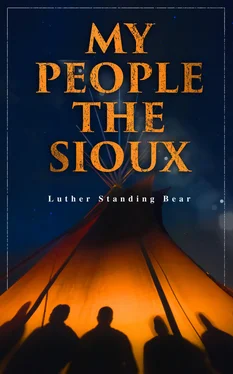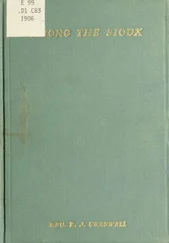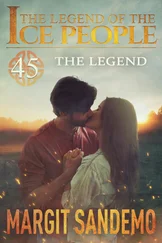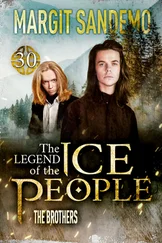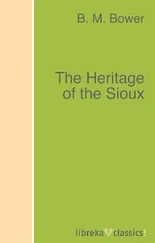In those days our women did not have any ‘sewing circles,’ but, when a tipi was to be made, they all got together with their sinews and awls—the latter made from the wing-bone of an eagle. They would all sit down and laugh and joke as they punched the holes with the awl and threaded the sinews which had been saved from the remains of the buffalo. This did not seem like work to our women.
When the new tipi was all ready to be put up, the old one was taken down, but the skin covering was not thrown away. Every bit of it was utilized to some good purpose. It was well smoked, and that made it waterproof. All the long winter, leggins and moccasins were made from the smoked skin. Sometimes a quiver was made to hold the bow and arrows. Later, when the Indians began to get guns, they also made cases for them out of the old hide, so that it was all utilized.
We did not have many cooking-utensils. When a buffalo was killed, the men were very careful in removing the stomach so as not to puncture it. The inside lining (or tripe) was washed and hung up on four sticks. This made a sort of bag suspended from the center of the sticks. All the meat was then washed and placed in the stomach-bag. Water and salt were added. Stones were then heated in a fire near by and put into this bag. The hot stones soon made the water boil, the meat was cooked, and presently we had soup all ready. We then sat down to a feast.
For plates we used the backs of turtles, while some were made from sections cut from trunks of trees and hollowed out. Spoons were made from the horn of the buffalo and the mountain goat. These horns were boiled until soft and then cut down the center. While they were yet hot, the men fashioned them into spoons. Some of these horns were larger than others, and from those was made a sort of dipper.
After all the soup and meat was cleaned out of the bag, it was then cut up and eaten. This was a great saving in dishwashing, as there were no pots to wash and our dishes were very few. At that time we knew nothing of coffee or bread. Our entire bill of fare consisted of meat and soup.
If the tripe was to be eaten without being made into a soup-bag, the outside skin was taken off very carefully. This skin was very strong. It was cleaned and tanned and hung inside the tipi to hold water. We did not need a cup with this sort of water-bucket. All that was necessary, when one wanted a drink of water, was to press the bottom up and the water came to the mouth of the bag. Occasionally our mothers would put wild mint leaves in the bag, and when we drank the water through these leaves, it tasted very good. In the summer time this water-bag was suspended under a tree, and we children did not have to go inside the tipi for a drink.
Our Indian women also made a delicacy called ‘wasna,’ or Indian hash. It was prepared by chopping up the bones and boiling them until soft and the grease came to the top. This was skimmed off and laid aside. Some dried meat was roasted and pounded fine with a stone hammer. Sometimes choke-cherries were added. Grease was then melted and mixed with the pounded choke-cherries and meat. This hash would keep for some time if rightly prepared. The women usually kept a skin from the tripe in which to wrap this hash, and it would harden somewhat after the manner of the white man’s head-cheese.
When a big feast was to be held, the woman who could bring out one of these skins full of hash felt very proud. When a man started on a long journey he usually carried some of this hash with him, as did the men who were going out on the war-path, as it was then not necessary to light a fire, which might betray the Indians to their enemies.
If a change in the bill of fare was desired, the women pounded some dried roasted meat until it was soft and tender. It was then served with the grease from the cooked bones—the same as the white man uses butter to add to the taste of his steak.
In the early spring, when we moved away from our winter quarters, our band of Indians looked better than any circus parade. Each family had its place in line. Nobody was ever in a hurry to get ahead of those in advance—as the white man in his automobile tries to do in this day and age.
In traveling, the ponies carrying the tipi poles of one family, went along together. Then came the pony that carried the tipi covering. This was folded in such a way that there was equal weight on each side. Next came the ponies with the bags. The rawhide bags hung on the saddle, one on each side of the pony. On top of these were the round bags, and in the center of these was that portion of the bed made from the branches strung on buckskin. As this was usually decorated, when rolled up it showed a great variety of colors.
The very young babies rode in a travois drawn by a very gentle pony, which the mother of the baby led, riding on her own pony. We bigger boys and girls always rode our own ponies, and we had plenty of fun chasing birds and hunting, until we came to the new camping-ground.
In all this hustle and bustle of moving, getting the children ready, and starting on the road, in spite of the fact that there were several hundred people, there was no confusion, no rushing hither and thither, no swearing and no ‘bossing.’ Every one knew we were moving camp, and each did his or her duty without orders. The entire camp would be on the road without any noise.
The old men of the tribe would start out first on foot. They were always in front, and we depended on them. They were experienced and knew the lay of the land perfectly. If the start was made before sunrise, it was beautiful to see the golden glow of the coming day. Then the old men sat down to wait for the sunrise, while the rest of us stood about, holding our horses. One of the men would light the pipe, and, as the sun came over the horizon, the entire tribe stood still, as the ceremony to the Great Spirit began. It was a solemn occasion, as the old man held the bowl of the pipe in both hands, and pointed the stem toward the sky, then toward the east, south, west, and north, and lastly, to Mother Earth. An appeal was made during this ceremony; the men smoked, after which the pipe was put away. Sometimes there would be something to eat on these occasions. After this ceremony was over, somehow we felt safer to go on.
The old men took the lead again, and when they reached a nice grassy place, with plenty of wood and water, they sat down. We then knew they had found a camping-place for the night, and everybody was happy. Every one then got busy locating a place to pitch his tipi. But there was no mad rushing around; we all took our time. Each woman put up her own tipi. Soon the whole camp showed a great circle of tipis, the fires were started, and we were shortly ready to eat. Meantime, the men turned the horses loose and attended to their wants.
Sometimes we would start off again the next morning. Sometimes we remained in one place several days. But as we were on our way to our summer home, in the northern part of Nebraska, and the distance was considerable, we children were anxious to be on the go again.
If there was any dispute about starting, the old men went to their tipi and counseled together. If it was decided to make a long journey the next day, one of the men would go around and warn every one to get to bed early, so as to be all prepared to start early in the morning. The women would make preparations to carry water along, in case we did not find any on the day’s march.
Very early the following morning, we could hear the call of the old man as he passed along by the tipis. He would call out ‘Co-oco-o!’ This meant, ‘Get up’—and we did. There was no asking of questions, such as, ‘What time is it?’ ‘Can I lie a little while longer?’ We boys always arose at once, to show that we were young men.
Our journey consumed quite a while. But we stopped when we wanted to and stayed as long as we pleased. There was no great rush. But finally we reached our destination, and our camp was soon settled. Then a scout was picked to go out for buffalo. When the scout returned, the hunters started out, camp was moved near to the place where the buffalo had been located, so the work would not be so hard on the women by being a great distance from camp. When the fresh meat was brought in, we all had a big feast, and were well pleased and satisfied to go to sleep at the end of another day.
Читать дальше
